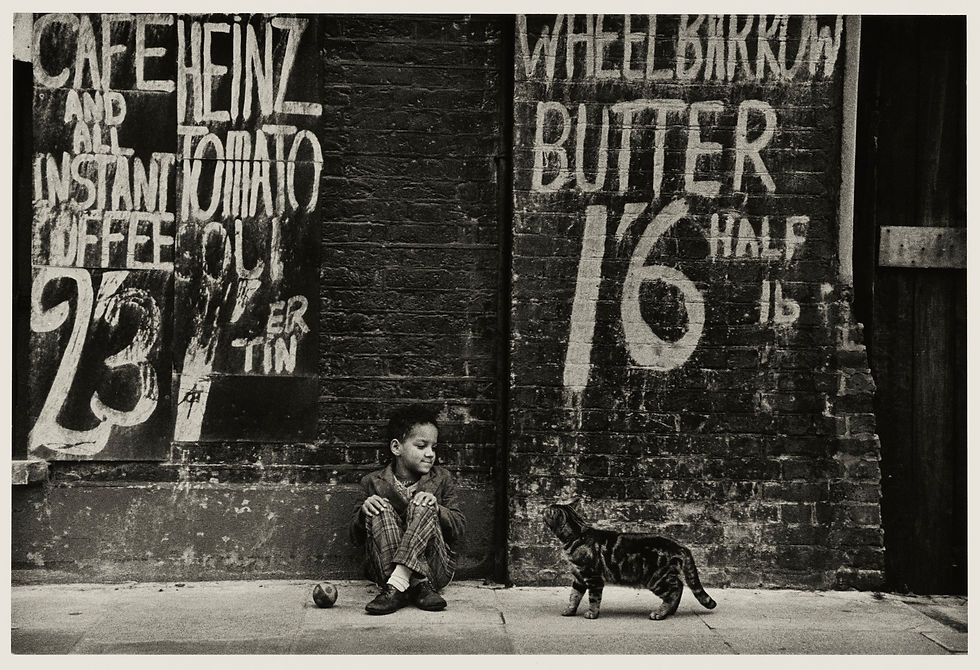Don McCullin
- Georgia Massie-Taylor
- Mar 5, 2019
- 4 min read
Tate Britain, Millbank, Westminster, SW1P 4RG
5 FEBRUARY - 6 MAY 2019
£18
Don McCullin grew up in a downtrodden Finsbury Park, London, in 1935. In 1958 he took a photograph of local London gang, 'The Guvnors', that would change his life entirely. Selling the photo in question to the Observer resulted in his career as a photojournalist to spiral, eventually leading him to work as the overseas correspondent for the Sunday Times between 1966 and 1984. McCullin's work is best known for hard-hitting and emotional depictions of conflict, working class life, and human desperation. He covered a number of wars, such as the Nigerian Civil War, the Vietnam War, and the Northern Ireland Conflict.

McCullin has an incredible eye; his images having the effect of immediately resonating with an audience. The struggles and pain of the subjects are brutally honest, and the content of his photographs undoubtedly harrowing. In 1964 McCullin won the World Press Photo of the Year award, for his cover of the war in Cyprus; the image below holding weight due to the sheer transparency of this particular woman's pain. Not only does McCullin have a craft for choosing his moments and composition, he also prints all of his work himself in his own darkroom. He is a man of undeniable talent, who has bore witness to some of the most tragic events in human history.

The exhibition begins in and around the London areas where McCullin was raised, where sweet children play with street-cats in the East End - the image below being taken in the Jewish District in 1962. Ten years later, Don McCullin returned to the East End as a subject, documenting many lives of the homeless community around these same areas, focusing strongly on a lady he befriended called Jean. These two groups of photographs show a contrast, but also a stark reminder that the living conditions and sheer human poverty remained a decade later, even in a city as affluent as London.

Famed for his gory, sensitive and stark images, McCullin hopes his work will motivate change by "breaking the hearts of secure people". The image below is from the Vietnam war, depicting a North Vietnamese soldier who fought against the Americans. After he has been killed, two American soldiers went through his belongings to see if there was anything worth stealing from his dead body. After witnessing this act, McCullin became defensive, and made his way over to the dead soldier - deciding for the first and only time in his career to intervene with the scene before taking the photograph. He re-arranged the soldiers belongings, which included a bag of bullets and photographs of loved ones, as he thought it helped the man regain some of his dignity and humanity: "He couldn't speak, so I spoke for him."

The stand-out image of the whole exhibition to me was the below image of a starving albino boy, taken during the Nigerian Civil War in Biafra. McCullin describes the abysmal conditions where numerous children were starving, and was drawn to this boy, as “Dying of starvation, he was still among his peers an object of ostracism, ridicule and insult." Shockingly skeletal, the boy is seen clutching a tin of food, which McCullin informs the viewer was actually empty, and the weary look on his face makes him appear to be more akin to an elderly man, not a young boy. Whilst the content of the image is horrific, you cannot help but stare in pure amazement that conditions such as these exist. I stood in front of his image for the longest time out of the whole exhibition, and returned to it at the end to view again. The effect it had on me was truly overwhelming, and after aiming to disguise the few tears which inevitably came, I could see a few others aiming to conceal similar feelings.

The section from Biafra continued to stun me into silence, another memorable image being that of a starving 24-year-old mother with her child. Once again, the mother looks way beyond her years; a look of utter dejection on her face. It is clear that the small child is going through the natural motions of trying to feed himself, yet the empty, flaccid breasts only serve to make this scene even more depressing. Committed to narrative, and showing the true nature of the scenes as he perceives them himself, McCullin is aware of the ethical dilemma in producing images of great beauty from human tragedy. However, he hopes that thorough his skilful composition and the stark reality of the images, they will stick in the minds of those that can help. His aim is, essentially, to make it impossible for us to ignore the atrocities taking place in the world in which we live and share as human beings.

The exhibition concludes with McCullin's still life and landscape photography of his later years, however, the effects of his past on his character continue to remain evident. Darkness pervades the landscapes, McCullin himself stating "People say my landscapes look like war scenes because I do print them very dark. But, you know, I suppose the darkness is in me, really." I can honestly say that I have never come away from any other exhibition where I have felt so utterly deflated and wholeheartedly moved. McCullin is an artistic genius, and has helped to portray scenes which the world need to be reminded of. At the end of the day, we are all human beings, and McCullin is reminding us here that no man is an island.

OVERALL RATING: *****
https://www.tate.org.uk/whats-on/tate-britain/exhibition/don-mccullin




















Comments